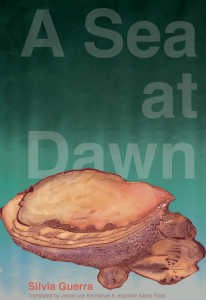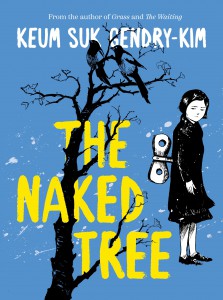This month, we take a look at two brilliant titles that embody the acts of interpretation and evocation. In Silvia Guerra’s poems, nature is given voice in stunning scenes of linguistic complexity. In Keum Suk Gendry-Kim’s retelling of a Korean classic, beloved characters are brought to life in the graphic form.

A Sea at Dawn by Silvia Guerra, translated from the Spanish by Jesse Lee Kercheval and Jeannine Marie Pitas, Eulalia Books, 2023
Review by Sofija Popovska, Editor-at-Large for North Macedonia
What constitutes a translation? Thinkers like Mikhail Bakhtin and Jacques Lacan have argued that every utterance is a deeply intimate expression channeled through shared, culturally standardized verbal structures; that is to say, every time we speak, we are translating.
As with speaking, so with listening, as well. Bakhtin describes the act of conversing with someone else as a (re-)construction of our concepts upon the “alien territory” of the other’s mind. In A Sea at Dawn (Un mar en madrugada), a poetry collection originally published in 2018 and now out in English translation from Eulalia Books, the Uruguayan poet Silvia Guerra manages to push against even these (admittedly broad and inclusive) boundaries of defining translation. In her panoramic, evocative poems, she invites all kinds of life, organic and inorganic, to speak, thereby creating a delightfully strange linguistic landscape that is equally alien and welcoming to the voices of the world, all at once.
Given the vertiginous and heterodox nature of the book itself, it’s helpful to start with the afterword written by the translators Jesse Lee Kercheval and Jeannine Marie Pitas, which illuminates the process of recasting Guerra’s captivating and difficult voice into English, and offers various ways to think about her poetry. For those that have read her in Spanish, it might seem that translating Guerra might seem an exercise in futility, leading to “disappointment and outright lamentation”; however, Kercheval and Pitas’ exquisite translation evokes neither of those things. Instead, contemplating Guerra’s intricate verbal designs allowed the translators to experience “lost and found” moments—instances where English revealed its ability to produce accomplices to Guerra’s “extremely innovative soundscapes” and formulations. Kercheval and Pitas cite an instance where they rediscovered the potential of English words to be “sonically evocative,” in which editor Michelle Gil-Montero offered “hacked in half” as a match for “pensamiento imbricado hendido”—instead of the initial idea, “thought interwoven split.” Later, quoting Walter Benjamin’s notion that “translation makes one’s native language foreign to itself,” Kercheval and Pitas’ afterword shows that reading Guerra in translation not only allows one to experience her mysterious Spanish transformed into English (A Sea at Dawn being a bilingual edition), but leaves our image of English irrevocably altered by her expansive, multipotential approach to language.
Kercheval and Pitas explain that, alongside the hermetic and experimental nature of Guerra’s words, one of the main challenges was transmitting ambiguity. The poet frequently uses third-person singular verbs without subject pronouns, allowing her to leave her subject undefined and lending the text that volatile “everything all at once” quality:
Volvía con la radio en el bolsillo
silbando una tonada que no
estaba a la moda.
Volvía desde el ignoto borde del silencio como arrastrando
peces de un mar en madrugada.
This hands-off approach demonstrates the radical inclusivity of her style: by not casting a precise actor for the action in her poems, every potential subject is included by virtue of possibility—everyone and everything that could be evoked in her poems, is. This principle doesn’t stop at the level of the sentence, but permeates individual words as well: as the translators divulge, when asked “if the word “prieto” was intended as “dark” or “tight”—[Guerra] immediately replied that it was both.” For the above passage, the translators opted to use the similarly “ample and unintrusive” pronoun of “you”:
You returned with the radio in your pocket
whistling a tune that was not
in style.
You came back from the unknown edge of silence as if dragging
fish from a sea
at dawn.
“Ambiguity is deliberate on Guerra’s part,” reveal Kercheval and Pitas, “as she is deeply interested in exploring subjectivity of many living things and inanimate objects.” Moreover, Guerra erases traditionally strict boundaries between the human and non-human by reconstructing her subjectivity on the alien terrain of mosses and birds, forests and animals—finding the personal and psychological amidst organic and inorganic otherness. This approach invests the reader with a feeling of profound situatedness in nature that is both comforting and unsettling. On one hand, feelings of alienation are reduced as we start to feel more at home among other beings. On the other hand, we begin to feel increasingly alienated from ourselves, seeing that experiences we have long interpreted as ‘the human condition’ can be found in every pocket of existence, merely coded in another language.
This becomes especially apparent in Musgo sobre una roca lisa (Moss on a Smooth Rock). The poem evokes visions of a forest reflected—and thus suffused—in a body of water: “Nocturnally tied / the aquatic whistling pine and / the goldfinch from the depths,” surrounded by a “fine horizon / and shivering straw / At the sides of / the line.” The submersion and delineation described in these lines engender an atmosphere of oppressive stillness. The forest wishes to free itself from containment within the oceanic oneness: “the tight torment / of being one / Of being two.” Resistance, however, proves futile: “The highest point won’t manage / to overflow the dike.”
As the forest is mirrored in the water, so the second half of the poem presents a personal, human experience as an equivalent to the first half’s nocturnal terrain. The speaker finds herself trapped next to someone whose back is turned to her in what appears to be a scene of erotic trauma: “Eyes on the nape of the neck / heart without rhythm / on this side / innocence Lost.” The line “on this side” is made more intense and unsettling by the preceding landscape imagery: the impossibility of the trees ‘escaping’ the water implies a dead end for the speaker as well. And, surely enough, the same futility permeates the speaker’s contemplations of defiance: “Any outbreak won’t make / Sense. / Any attempt / A dead body.” The power of parallels in this poem is not to be underestimated: not only do the human and nonhuman experiences serve to complete and explain each other, but also, by locating the feelings of crisis and ensnarement in both of these realms, Guerra demonstrates their omnipresence, thus lending these emotions an almost overwhelming intensity.
Guerra’s approach isn’t just powerful, it is also extremely versatile. Throughout A Sea at Dawn, we find quiet joy and absolute desolation, feminine experiences and a fictionalized biography of Lautréamont, linguistic exploration and observations on art, all rendered beautifully into English by Kercheval and Pitas. As a first-time reader of Guerra’s writing, I was both dizzied and enamored by its delicious heterogeneity; upon finishing the collection, I was left thinking that A Sea at Dawn is one of what Roberto Bolaño called “torrential works, books that blaze paths into the unknown.”

The Naked Tree by Keum Suk Gendry-Kim, translated from the Korean by Janet Hong, Drawn & Quarterly, 2023
Review by Irmak Ertuna Howison, Educational Arm Assistant
Set during the Korean War, Keum Suk Gendry-Kim’s The Naked Tree brings a classic coming-of-age story to life with striking lines and minimalist, emotionally packed images. The graphic novel is a brilliant adaptation of Park Wan-suh’s 1970 work The Naked Tree, a Korean classic which depicts the everyday life during Korean War as experienced by the twenty-year-old protagonist Lee Kyong; in the postscript, Gendry-Kim writes that she “wanted to give it my own touch without deviating too much from the original, but as I worked on it, it soon became something very different.” The main differences consist of additional characters and alterations in the narrative structure—both of which serve to convey the contemporary artist’s interpretation of the classic at its seventieth anniversary. By pairing Park’s original characters with graphic visuality, Gendry-Kim makes apparent the different lives of the same story as told by various authors, and the changes made in narrative structure also help readers situate the events of the novel in their proper historical context.
The novel’s protagonist, Lee Kyeonga, works at the US military post exchange, where soldiers can buy duty-free American goods. Her job, however, is on the opposite side of the post exchange, away from the dazzling American products, and her responsibilities are a unique war enterprise: to solicit orders from American soldiers for hand-painted silk handkerchief portraits, and to supervise the painters who make them. The sign-painters—or signies, as they’re called—try to make a living by painting the girlfriends of soldiers from given photographs, while Kyeonga assigns the commissions. The narrative is propelled by the arrival of a melancholic new painter, Ok Huido, who transforms something in the young protagonist. Filled with feelings of admiration, compassion, and tenderness, Kyeonga develops a romantic attachment to Ok Huido, who is married. The innocent romance between the two is interspersed with scenes of war, family struggles, and Kyeonga’s problematic relationship with her grieving mother.
This is a beautiful and touching coming-of-age story, set in a time fraught with unique racial and sexual tensions. As Kyeonga navigates the streets of Seoul, finding her own ways of surviving her bleak reality, she also observes other women trying to make ends meet by soliciting American soldiers—who, for the most part, look for temporary escape in these women they view as inferior. Despite the brutal landscape around her, Kyeonga remains strong-willed, refusing to let her life be dictated by the losses of the war, yet her conflicting feelings of guilt and compassion regarding her family add an intricate layer of emotion to the story. The eventual, elegant depiction of her sexual awakening in the graphic novel is a portrayal of independence and strength, an act of respite against the forces conspiring against young women at the time.
Often, a new form, such a graphic novel or a cinematic adaptation, draws younger generations into the classics, and with her adaptation, Gendry-Kim does not only present the lesser-known aspects of the Korean War, but also illustrates the universal struggles of adolescent women when trying to carve a space for themselves in the society. This flawless English translation of the graphic novel will captivate and touch the readers across the continents.
*****
Read more on the Asymptote blog:

